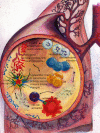Immune mechanisms and the impact of the disrupted lung microbiome in chronic bacterial lung infection and bronchiectasis
- PMID: 23286938
- PMCID: PMC3573282
- DOI: 10.1111/cei.12003
Immune mechanisms and the impact of the disrupted lung microbiome in chronic bacterial lung infection and bronchiectasis
Abstract
Recent studies analysing immunogenetics and immune mechanisms controlling susceptibility to chronic bacterial infection in bronchiectasis implicate dysregulated immunity in conjunction with chronic bacterial infection. Bronchiectasis is a structural pathological end-point with many causes and disease associations. In about half of cases it is termed idiopathic, because it is of unknown aetiology. Bronchiectasis is proposed to result from a 'vicious cycle' of chronic bacterial infection and dysregulated inflammation. Paradoxically, both immune deficiency and excess immunity, either in the form of autoimmunity or excessive inflammatory activation, can predispose to disease. It appears to be a part of the spectrum of inflammatory, autoimmune and atopic conditions that have increased in prevalence through the 20th century, attributed variously to the hygiene hypothesis or the 'missing microbiota'. Immunogenetic studies showing a strong association with human leucocyte antigen (HLA)-Cw*03 and HLA-C group 1 homozygosity and combinational analysis of HLA-C and killer immunoglobulin-like receptors (KIR) genes suggests a shift towards activation of natural killer (NK) cells leading to lung damage. The association with HLA-DR1, DQ5 implicates a role for CD4 T cells, possibly operating through influence on susceptibility to specific pathogens. We hypothesize that disruption of the lung microbial ecosystem, by infection, inflammation and/or antibiotic therapy, creates a disturbed, simplified, microbial community ('disrupted microbiota') with downstream consequences for immune function. These events, acting with excessive NK cell activation, create a highly inflammatory lung environment that, in turn, permits the further establishment and maintenance of chronic infection dominated by microbial pathogens. This review discusses the implication of these concepts for the development of therapeutic interventions.
© 2012 British Society for Immunology.
Figures
References
-
- Boyton RJ, Openshaw PJ. Pulmonary defences to acute respiratory infection. Br Med Bull. 2002;61:1–12. - PubMed
-
- Boyton RJ. Bronchiectasis. Medicine. 2012;40:267–272.
-
- Cole P. A new look at the pathogenesis and management of persistent bronchial sepsis: a ‘vicious circle’ hypothesis and its logical therapeutical connotations. In: Davies RJ, editor. Strategies for the management of chronic bronchial sepsis. Oxford: The Medicine Publishing Foundation; 1984. pp. 1–20.
Publication types
MeSH terms
Substances
Grants and funding
LinkOut - more resources
Full Text Sources
Other Literature Sources
Medical
Research Materials


